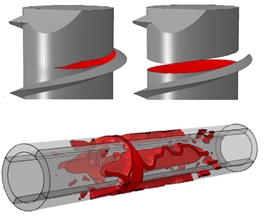Progress and opportunities in modelling environmentally assisted cracking
DOI:
https://doi.org/10.21809/rilemtechlett.2021.145Keywords:
Multi-physics, hydrogen embrittlement, stress corrosion cracking, phase field, corrosion fatigueAbstract
Environmentally assisted cracking phenomena are widespread across the transport, defence, energy and construction sectors. However, predicting environmentally assisted fractures is a highly cross-disciplinary endeavour that requires resolving the multiple material-environment interactions taking place. In this manuscript, an overview is given of recent breakthroughs in the modelling of environmentally assisted cracking. The focus is on the opportunities created by two recent developments: phase field and multi-physics modelling. The possibilities enabled by the confluence of phase field methods and electro-chemo-mechanics modelling are discussed in the context of three environmental assisted cracking phenomena of particular engineering interest: hydrogen embrittlement, localised corrosion and corrosion fatigue. Mechanical processes such as deformation and fracture can be coupled with chemical phenomena like local reactions, ionic transport and hydrogen uptake and diffusion. Moreover, these can be combined with the prediction of an evolving interface, such as a growing pit or a crack, as dictated by a phase field variable that evolves based on thermodynamics and local kinetics. Suitable for both microstructural and continuum length scales, this new generation of simulation-based, multi-physics phase field models can open new modelling horizons and enable Virtual Testing in harmful environments.

Downloads
Published
How to Cite
Issue
Section
License
Authors retain copyright of the articles published in RILEM Technical Letters and grant the journal the right of first publication with open access. The work is simultaneously licensed under Creative Commons Attribution 4.0 International License (CC BY 4.0) that allows others to share and adapt the work under the following terms: 1) a proper attribution is given in a form of a reference to the original work's authorship and initial publication in RILEM Technical Letters (bibliographic record with the DOI link); 2) a link to the license is provided; 3) the changes (if any) are indicated.









